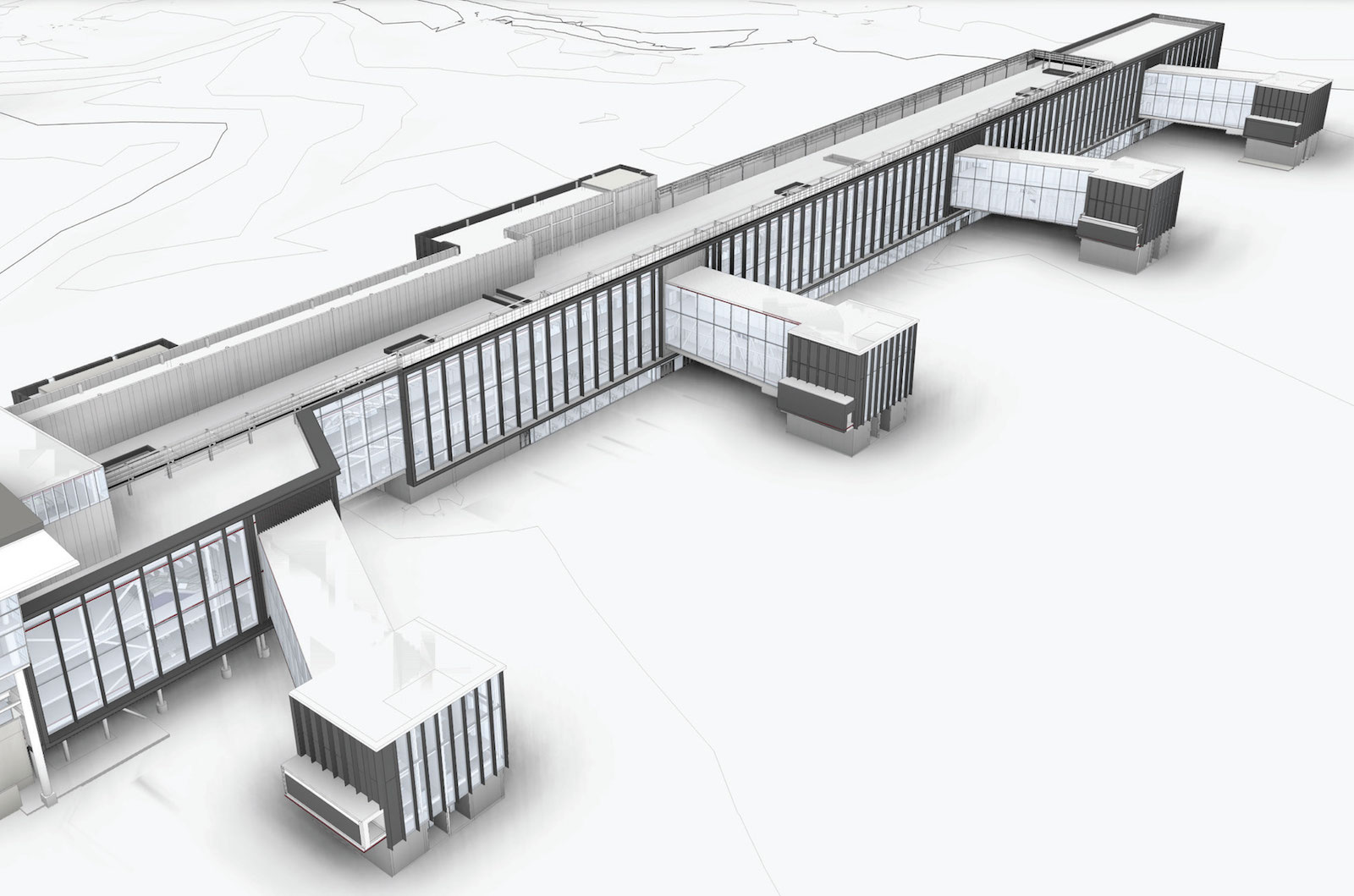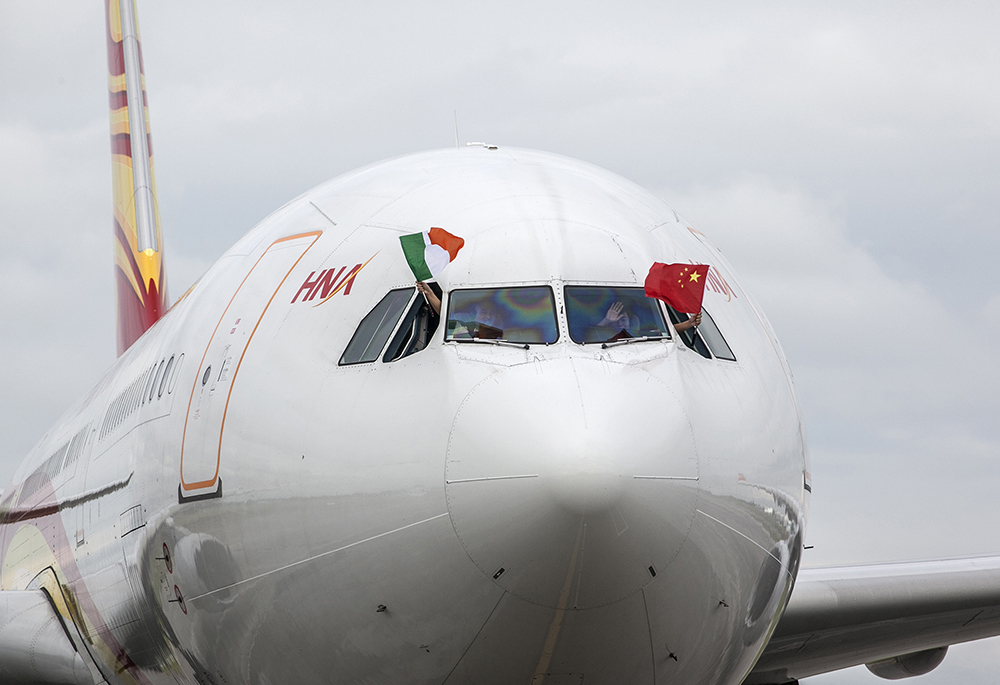7.2 Enabling infrastructure to facilitate Airport growth
The following objectives support the delivery of aviation transport capacity enhancing infrastructure that will be crucial in building the Airport’s strategic role as a European hub airport in line with government policy.
Proposals brought forward shall have regard to the requirement for environmental assessment including screening for Appropriate Assessment, Environmental Impact Assessment and Flood Risk Assessment in accordance with relevant legislation and guidelines.
Proposals for increased capacity enhancing infrastructure shall take into account safeguarding associated with key operational features of the Airport (runways, taxiways, obstacle surfaces, radar and control tower sightlines).
It is important that all future development proposals shall not prejudice the orderly operation and continued growth at Dublin Airport. This also includes the consideration of the provision of a third terminal discussed below at Section 7.2.1.
OBJECTIVE EA1
All development proposals at Dublin Airport shall have regard to the requirement for environmental assessment including screening for Appropriate Assessment, Environmental Impact Assessment and Flood Risk Assessment in accordance with relevant legislation and guidelines.
OBJECTIVE EA2
All development proposals in the LAP area shall safeguard key operational features of the Airport (runways, taxiways, obstacle surfaces, radar and control tower sightlines).
OBJECTIVE EA3
All development proposals shall not prejudice the orderly operation and continued growth of the Airport including provision of a third terminal in the future.
7.2.1 TERMINALS
The DTTAS Review identifies internal congestion points in the existing terminals as a capacity challenge during the LAP period. There is an immediate need to increase capacity and service levels within departure and arrivals processing facilities, immigration and baggage reclaim and for further passenger connectivity with the addition of gate and pier development. The DTTAS review indicates that incremental expansion of T1 and T2 is desirable in the short term to achieve capacity of 40 mppa37.
Within T1, focused re-configurations and incremental development will primarily support additional ‘point to point’ services, which are the principal form of operation from that terminal. They rely on fast turnaround times to optimise operating efficiencies and in the main are operated by narrow body or turbo-prop aircraft with some stands also being able to accommodate a limited number of wide- body turnarounds.
Within T2, focused development will predominantly, though not exclusively, be designed to accommodate the strong growth in
transatlantic traffic that the Airport is experiencing. It is aimed to increase pier infrastructure (particularly serving T2) and the number of widebody stands that are available over the period of this plan. Reconfiguration and redevelopment will also encourage additional onward movement of passengers, by improving transfer and US pre- clearance facilities in line with national policy objectives to promote Dublin as an international hub.
The DTTAS Review identifies the need for a third terminal to facilitate anticipated growth in the longer term. The timing around a third terminal, however, needs to consider any measures to remodel T1 and T2 beyond approximately 40 mppa. The DTTAS Review cites a target date of 2031 for the delivery of T3. While this is outside the life span of this LAP, it is considered necessary to explore an appropriate location for T3 in the immediate term, in view of the long lead in times for such projects. In this regard, the DTTAS Review identifies the following 3 no. potential locations for T3 within the ‘DA’ Dublin Airport zoned lands as follows:
-
North-East of T1
-
North-West of T1
-
West of runway 16/34
The options provide an opportunity for strategic stakeholder discussions and engagement on the future development of Dublin Airport. In this regard, these potential options should be examined through further studies to determine the optimal location for T3 by the relevant strategic stakeholders. In the interim, the ‘DA’ zoning objective within this LAP provides an adaptive land-use which supports aviation and related uses. This allows for appropriate new terminal development to be considered subject to necessary environmental and surface access assessments.
TERMINAL OBJECTIVES
OBJECTIVE TP1
Facilitate the on-going augmentation and reconfiguration of existing terminal facilities at Dublin Airport to ensure optimal use, subject to assessment of surface access constraints.
OBJECTIVE TP2
Support and facilitate the expansion and enhancement of US preclearance facilities.
OBJECTIVE TP3
Support the detailed review of the three idenfified locations for a third terminal at Dublin Aiport as set out in the Department of Transport, Tourism and Sport (DTTAS), ‘Review of Future Capacity Needs at Ireland’s State Airports’, (August 2018) during the lifetime of this LAP with a view to identifying the most appropraite location.

7.2.2 RUNWAY
Dublin Airport experiences significant slot pressures during peak periods resulting in potential for delays. Additonal capacity will be provided on completion and operation of the new north runway in 2022.
RUNWAY OBJECTIVES
OBJECTIVE RW1
Facilitate the operation of runways at Dublin Airport in line with current operational procedures, as determined by way of existing planning permissions or as otherwise determined in line with the requirements of the Aircraft Noise (Dublin Airport) Regulation Act 2019.
7.2.3 TAXIWAYS
The north runway, which is currently under construction, has been designed and approved with a full set of Rapid Exit Taxiways [RETs] and an associated parallel taxiway system. This facilitates movement of planes into take-off position and off the runway in the most efficient manner. As the type of aircraft using the Airport changes and the spacing allowed between departing and arriving aircraft made more efficient, the most effective layout of RETs may change. Additional RETs may also be required. To facilitate the efficiency of airside operations, the LAP supports the development, amendment and enhancement of existing taxiways that may be required.
TAXIWAY OBJECTIVES
OBJECTIVE TW1
To facilitate the development, amendment and enhancement of existing taxiways where required to improve the efficiency of airside operations.
7.2.4 AIRCRAFT PARKING STANDS, PIERS AND BOARDING GATES
To meet forecast air traffic demand, additional aircraft stands and passenger boarding gates as well as modifications to this exisitng infrastructure will be required during the plan period to provide greater capacity. To serve upgraded and additional aircraft parking stands, additional piers and modifications to existing pier buildings which accommodate boarding gates will also be required.
Increased provision of aircraft parking stands, piers and gates capacity will become increasingly important during the plan period to faciltate the Airport’s strategic role as a European hub airport.
AIRCRAFT PARKING STANDS, PIERS AND BOARDING GATE OBJECTIVES
OBJECTIVE SBG1
Facilitate the development of new stands, piers and boarding gates in line with the expansion of associated runway and terminal capacity across the Airport having regard to the need to protect key operational areas.
OBJECTIVE SBG2
Provide improved and expanded parking facilities for aircraft.

7.2.5 APRON
In order to facilitate forecasted demand in air traffic and improvements to services and airfield operations, re-ordering or provision of new aprons areas will be required. This may be due to the need to facilitate additional capacity at terminals, piers and aircraft stands as well as cargo areas. The LAP is supportive of the provision of new apron areas, however it must be demonstrated that any new or extended apron locations will not prejudice the locations for a new third terminal as set out in Section 5.4.2 of the DTTAS Review of Future Capacity Needs at Ireland’s State Airports.
APRON OBJECTIVES
OBJECTIVE AP1
Facilitate the orderly expansion and the enhancement of existing aprons where required to support airfield infrastructure and operations.
OBJECTIVE AP2
Facilitate the efficient operation of existing and new apron areas.
7.2.6 AIR CARGO
In line with the National Aviation Policy, the LAP recognises the important supporting role of cargo facilities at Dublin Airport and promotes the maintenance and continued growth of such facilities.
The provision of improved apron facilities serving cargo operations could allow for the relocation of existing cargo operations from the eastern campus. This would facilitate maximising the ability of this campus to accommodate expanded passenger capacity and services. Applications to expand cargo facilities shall be accompanied by a demonstration of need, along with an operational overview of existing and proposed facilities, site specific flood risk assessment and transport assessment.
CARGO OBJECTIVES
OBJECTIVE CG1
Facilitate air cargo operations though the provision of improved apron facilities.
OBJECTIVE CG2
Facilitate the relocation and expansion of new cargo facilities and potential consolidation of air cargo operations, subject to site specific flood risk assessment and transport assessment.
7.2.7 MAINTENANCE REPAIR AND OVERHAUL (MRO)
In line with the National Aviation Policy, the LAP recognises the important supporting role of maintenance repair and overhaul (MRO) facilities at Dublin Airport, particularly as the Airport continues to grow. In this regard, the LAP promotes the maintenance and continued growth of such facilities.
As aircraft parking stand and pier facilities expand to meet demand, existing MRO facilities may require relocation. Relocating the extant MRO facilities from the eastern campus would serve to maximise the ability of this campus to accommodate expanded passenger capacity and services. In the event of relocation, a careful balance is required between the need for relocation, having regard to the impact on neighbouring uses. Applications to expand/relocate aircraft MRO facilities shall be accompanied by a demonstration of need, along with an operational overview of existing and proposed facilities and have regard to impact on neighbouring uses.
MAINTENANCE REPAIR AND OVERHAUL (MRO) OBJECTIVES
OBJECTIVE HM1
Facilitate and support the provision of aircraft maintenance, repair and overhaul (MRO) facilities.
OBJECTIVE HM2 F
Facilitate the relocation and potential consolidation of maintenance, repair and overhaul (MRO) facilities. Such planning applications shall be accompanied by a demonstration of need, along with an operational overview of existing and proposed facilities and shall have regard to impact on neighbouring uses.

- 37 - Million passengers per annum.